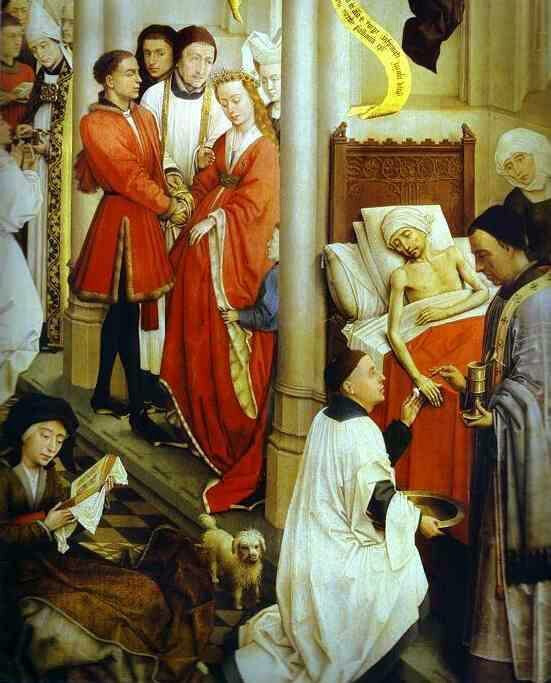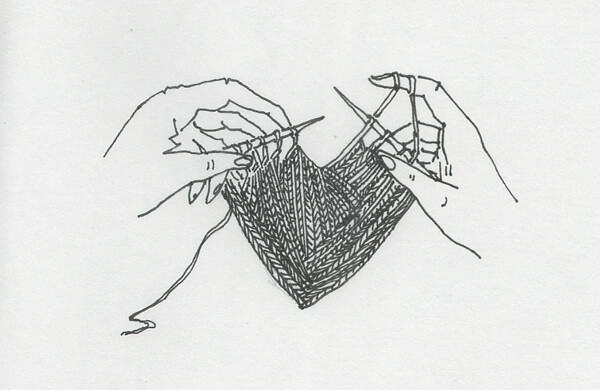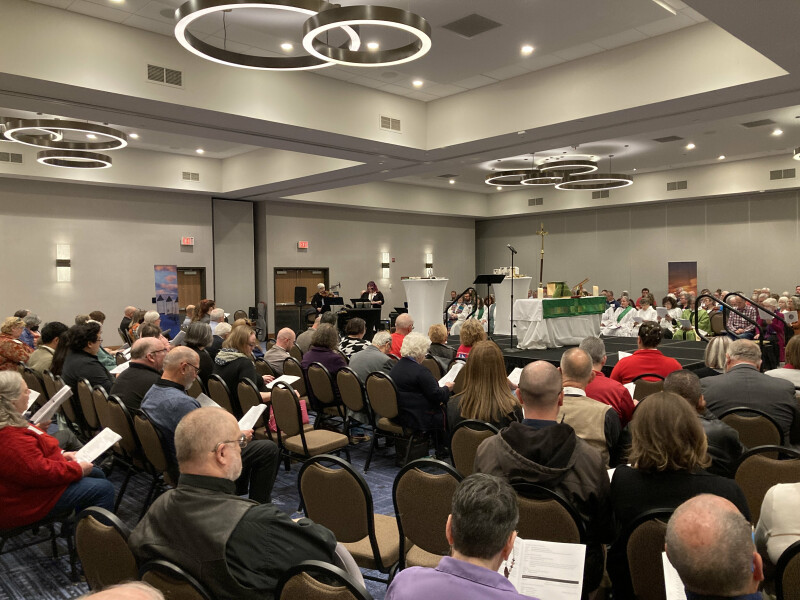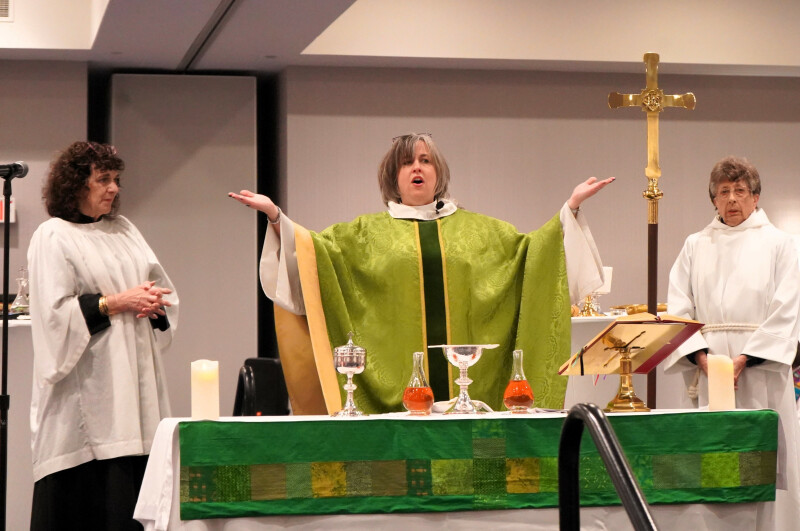Ask a Theologian: Anointing

Image: "Extreme Unction," part of The Seven Sacraments (1445–1450) by Rogier van der Weyden
Dear Theologian,
When my uncle was in the hospital with a serious illness, a priest came to visit him and anointed his forehead with oil. I know that this is one of the Church’s sacraments, but I’m not sure that I understand its meaning. Why is it done, and what effect does it have?
Unsure
Dear Unsure,
To answer this question, we have to look briefly at the history of anointing in the Church. The classic text for this practice is in the Letter of James:
“Are any among you sick? They should call for the elders of the Church and have them pray over them, anointing them with oil in the name of the Lord. The prayer of faith will save the sick, and the Lord will raise them up; and anyone who has committed sins will be forgiven.” (Jas 5:14-15)
The symbolism of anointing with oil is easy to appreciate, since this is clearly an act of soothing and comforting. There is, however, hardly any evidence that the anointing of the sick was practiced as a liturgical ceremony performed by priests during the first eight centuries of Christianity. There is evidence that oil was blessed by the bishop and was used by the faithful as a kind of remedy for illness (not merely by anointing the body, but even by tasting and consuming the oil). The significant thing was the blessing of the oil by the bishop, which made the oil itself the bearer of sacred power.
Beginning around the ninth century, there was a formalizing of the ritual of anointing, and it was reserved for the priest to perform. Around the same time, this anointing began (apparently for the first time) to be closely associated with deathbed penance and the immediate preparation for death.
This development was complete and taken for granted by the time the theology of the sacraments was worked out by the scholastic theologians in the twelfth and thirteenth centuries. Hence, the meaning attributed to this anointing was almost exclusively the consecration of the person for death, the “last anointing” (extrema unctio).
This understanding of anointing made the appearance of a priest at the sickbed an omen of impending death. Hence, people postponed the anointing as long as possible, since having it done was equivalent to giving up all hope. Thus, what historically was originally a sign of comfort and hope had become a sign of death, inspiring terror.
It must be recognized that the concept of “last anointing” was a secondary development, to be understood in terms of the historical circumstances of the Dark Ages. The theology of the scholastics was simply an interpretation of a practice that they took to be immemorial. But now—with the aid of better historical knowledge—we can see that this theology is not well founded in either Scripture or the first eight centuries of the Tradition.
Therefore, a contemporary theology of the sacrament of anointing puts the emphasis once again on the healing and strengthening of a person who is seriously ill (whether or not at the point of death). But how are we to understand this ritual, and what effect is it thought to have?
When one is seriously ill there is weakness, pain, a sense of mortality. Even if one is not in immediate danger of death, the fragility and finitude of one’s human condition is experienced very strongly. The ultimate reality of death is somehow present in one’s awareness. At the same time, one is estranged and alienated from the normal world of work, play, interpersonal contacts and interactions. One lies isolated. One is dependent on others, yet somewhat cut off from them.
In such a situation the believer very much needs to interpret all this in the context of explicit Christian faith. But it is precisely when one is ill that prayer and faith sometimes become difficult, if not impossible. One feels the need for a vision of faith, but is often unable to rise to that level of awareness.
In view of this general situation of the sick person, the Church has a “ministry” to those of its members who are sick. This ministry involves “visiting the sick,” in order to take care of that person’s needs in whatever way is most appropriate. Medical attention is normally provided by health-care professionals. What is not ordinarily provided by doctors and nurses is meaning. What does all this suffering and helplessness mean? How can one understand his or her situation in relation to God?
The Church ministers to this need for meaning when its members come to visit the sick person. In many cases, it is the priest or deacon who comes, representing the entire faith community. He or she does not provide glib, ready-made answers, but makes present the good news of Jesus through conversation and reading of Scripture, and by praying with this person.
All this ministry receives a ritualized, sacramental expression in the sacrament of the anointing of the sick. This ritual will be most meaningful, in fact, only if there is such a context of pastoral care of the sick person. Without such a context, the simple action of anointing will probably not have the same depth or resonance of meaning.
The sacrament of anointing, therefore, communicates meaning by relating this person’s suffering to the Paschal Mystery of Christ (his death and resurrection). Moreover, the representative of the faith community who comes to visit helps the sick member to overcome the experience of isolation and estrangement that goes with being sick. The visitor embodies for him or her the faithful love of the Father, as revealed in the Son.
Now, instead of experiencing estrangement, one can experience connectedness, acceptance, love, and oneness with the community. Through this, he or she can be reassured of being enfolded in God’s love and cared for. He or she may be brought to the point of surrender in faith, of abandonment to God’s love.
In this attitude of faith, one is open to the healing power of God, and physical healing sometimes follows. The same attitude of radical openness to God can, however, also lead to a peaceful sharing in the mystery of Jesus’ death, as one hands over his or her life completely to the God who has raised Jesus from the dead.
All this is appropriate to any situation of serious illness, even if there is no question of the immediate danger of death. Of course, it is also appropriate if a person is near death. In fact, the mystery of death announces itself in any serious illness, and the logic of faith is always the same.
Faithfully,
The Theologian
The Rev. Wayne L. Fehr writes a monthly column for the diocesan newsletter called "Ask a Theologian," answering questions from ordinary Christians trying to make sense of their faith. You can find and purchase his book "Tracing the Contours of Faith: Christian Theology for Questioners" here.

 image: Liz Valente, https://www.instagram.com/donalizvalente/
image: Liz Valente, https://www.instagram.com/donalizvalente/
